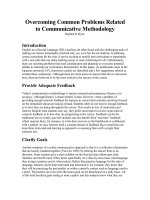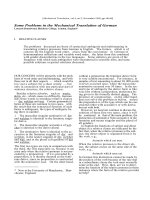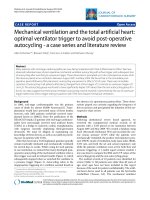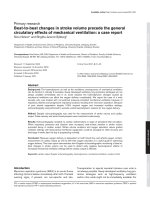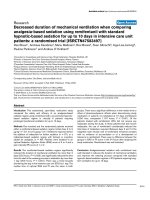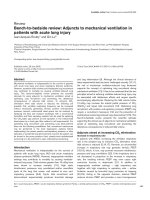Some problems relate to mechanical ventilation physiotherapy
Bạn đang xem bản rút gọn của tài liệu. Xem và tải ngay bản đầy đủ của tài liệu tại đây (7.47 MB, 48 trang )
BỆNH VIỆN ĐẠI HỌC Y DƯỢC TP. HCM
KHOA PHỤC HỒI CHỨC NĂNG
Some Problems Relate To Mechanical
Ventilation - Physiotherapy
BS. Nguyễn Võ Hoàng Phúc
BS. Nguyễn Đức Thành
Khoa Phục Hồi Chức Năng
Bệnh Viện Đại Học Y Dược TPHCM
CONTENTS
Introduction MV
Basic physiology of MV
Complications
of cơ
MV
Yếu tố nguy
Sedation vs MV
Mobilization in patient with MV
SAFEMOBE in patient with MV
Introduction
“Mechanical ventilation (MV) is the most used
short-term life support technique worldwide”.
Over the last 50 years, MV has been an
important tool:
Maintaining a patient’s breathing
Improving patient survival and recovery from lifethreatening diseases.
The mortality rate in intensive care units has
notably decreased.
Tài Pham, Brochard L.J. (2017), “Mechanical Ventilation: State of the Art”, Mayo Clinic Proc, vol 92(9), pp 1382-1400
Wang T.H. (2020), “EEarly mobilization of mechanically ventilated patients in the intensive care unit”, pp 1-20.
Introduction
• Beginning: In the 16th
century Andreas Vesalius
• Four centuries later, “the
iron lung: the first negativepressure ventilator
successfully used in clinical
practice”
Tài Pham, Brochard L.J. (2017), “Mechanical Ventilation: State of the Art”, Mayo Clinic Proc, vol 92(9), pp 1382-1400
Introduction
• 1952, Bjorn Iben (Blegdams Hospital )-> tracheostomy and positive-pressure ventilation to
treat patients with paralytic poliomyelitis mortality decreased from 87% to 40%.
• 1954, Claus Bang & Carl-Gunnar Engstrưm developed the first efficient mechanical
ventilator.
• The first arterial blood gas analyzers were built shortly thereafter
• 1967, Ashbaugh -> the use of positive end-expiratory pressure (PEEP) : ARDS
• 1972, Servo 900A (Siemens-Eléma): the first mechanical ventilator with PEEP
• In the United States: 310 persons/100,000 adult population undergo invasive ventilation
for nonsurgical indications
Tài Pham, Brochard L.J. (2017), “Mechanical Ventilation: State of the Art”, Mayo Clinic Proc, vol 92(9), pp 1382-1400
Indications of MV
• (1) airway protection for a patient with a decreased level of
consciousness (eg, head trauma, stroke, drug overdose,
anesthesia)
• (2) hypercapnic respiratory failure due to airway, chest wall, or
respiratory muscle diseases
• (3) hypoxemic respiratory failure
• (4) circulatory failure
• (5) Cardiac or respiratory arrest
Tài Pham, Brochard L.J. (2017), “Mechanical Ventilation: State of the Art”, Mayo Clinic Proc, vol 92(9), pp 1382-1400
Basic physiology of MV
Understanding of the basic
physiology of MV -> necessary to
optimally apply MV
4 elements determining the phases
of the respiratory cycle
Time
Pressure
Flow
Volume
Tài Pham, Brochard L.J. (2017), “Mechanical Ventilation: State of the Art”, Mayo Clinic Proc, vol 92(9), pp 1382-1400
Basic physiology of MV
The modes of MV are commonly defined by 4 elements
Phases of a breath:
1) The trigger phase initiates a breath.
• The ventilation is fully controlled the trigger variable is time
• The ventilator synchronizes the breath to the patient’s effort
the trigger variable: flow or pressure decrease
Tài Pham, Brochard L.J. (2017), “Mechanical Ventilation: State of the Art”, Mayo Clinic Proc, vol 92(9), pp 1382-1400
Basic physiology of MV
2) The target (or controlled) phase:
pressure or flow will be maintained until the
inspiration ends.
3) The cycling phase determines the end of
the inspiratory phase
4) The passive expiratory phase:
- A pressure, flow, or a preset time reaches
the preset value
- The expiratory control variable: a
pressure (PEEP)
Tài Pham, Brochard L.J. (2017), “Mechanical Ventilation: State of the Art”, Mayo Clinic Proc, vol 92(9), pp 1382-1400
Basic physiology of MV
Therefore, Breaths can be:
Fully controlled-trigger: the patient does not actively
contribute to the breath
Partially supported: a combination of ventilator assistance and
patient effort occurs in the same cycle
Unassisted: The breath is generated entirely by the patient’s
respiratory muscles
Tài Pham, Brochard L.J. (2017), “Mechanical Ventilation: State of the Art”, Mayo Clinic Proc, vol 92(9), pp 1382-1400
Modes of MV
Complications of MV
Pneumonia
Lung injury
Critical illness neuromuscular abnormalities: respiratory
muscle dysfunction atrophy of the diaphragm
Hemodynamic Effects: hypotension
Sedation toxicity
Oxygen toxicity
Tài Pham, Brochard L.J. (2017), “Mechanical Ventilation: State of the Art”, Mayo Clinic Proc, vol 92(9), pp 1382-1400
Sedation - MV
In the early phase of MV sedation is often required, especially
for patients:
• Shock
• ARDS
• “Fighting the ventilator”
84% ICU in USA (1991), 33% ICU in Denmark used sedation
Sedation - MV
Role of sedation:
• Minimize agitation
• Promote synchrony with the ventilator
• Relieve the anxiety and discomfort
“asleep but easily rousable”
Jonghe B.D., CooK D. et al (2000), “Using and understanding sedation scoring systems: a systematic review”,
Intensive Care Med, Vol 26, pp. 275 - 285
Sedation - MV
Inappropriate administration of sedation serious
consequences:
Insufficient sedation -> life-threatening agitation myocardial
ischemia or ventilator dysynchrony
Excessive sedation prolonged alteration of consciousness
Increased duration of mechanical ventilation
Jonghe B.D., CooK D. et al (2000), “Using and understanding sedation scoring systems: a systematic review”,
Intensive Care Med, Vol 26, pp. 275 - 285
Sedation - MV
Tools for sedation: measure the effectiveness of sedation
Simple
User-friendly at the bedside
Demonstrated: validity, reliability and responsiveness
Jonghe B.D., CooK D. et al (2000), “Using and understanding sedation scoring systems: a systematic review”,
Intensive Care Med, Vol 26, pp. 275 - 285
Sedation - MV
*Tools for sedation:
1974: Ramsay
Prior 2001, three scales tested for reliability and validity:
VICs, SAS, MAAS.
2001: RASS
After 2001: Luer (2001), ATICE (2003), Bloomsbury (2004),
MSAT (2004), SEDIC (2006)…
Sedation - MV
RAMSAY SCALE
oth
ysi
Ph
py?
era
Sedation - MV
i
Phys
?
rapy
othe
Yousefi H., el al (2015), Vol 20(6), “Effect of using Richmond Agitation Sedation Scale on duration of mechanical ventilation, type and
dosage of sedation on hospitalized patients in intensive care units”, Orinal Research, pp 700-704
Mobilization in patient with MV
Mobilization is used: a treatment technique for patients with MV
The aims of mobilization:
• Improving respiratory function:
optimizing ventilation, increasing lung
volumes, and improving airway
• Reducing the adverse effects of
immobility
• Increasing levels of consciousness
• Increasing functional independence
• Improving cardiovascular fitness
• Increasing psychological well being
• Reduce incidence of pulmonary
complications
• Hasten recovery
• Decrease the duration of
mechanical ventilation
• Decrease the length of ICU or
hospital stay
Stiller K., et al (2007), “Safety issues that should be considered when mobilizing critically ill patients”, Crit Care Clin 23, 35–53
Roles of Early Mobilization In Patient With MV
Reducing length of patient stay in the ICU.
Reducing length of hospital stay.
Reducing patient’ outcomes.
Reducing overall hospital cost.
Reducing length of connetion to ventilator.
Improving cardiopulmonary function
Improving muscleskeletar system ’ function.
Balley B., Thomsen G.E., et al, ″Early activity is feasible and safe in respiratory failure patients″, Crit Care Med, 2007, 35(1), pp 139 – 145
Dang S.L. (2013), ″ABCDEs ICU: Early Mobility″, Crit Care Nurs Q, vol 36 (2), pp 163 -168
Perme C., Nawa R.K., Winkelman C., Masud F. (2014), ″A tool to assess mobility status in critically ill patients: the Perme Intensive Care Unit Mobility Score″, Methodist Debakey Cardiovasc J, vol 10(1), pp 41-49
When is early mobilization?
Clarissa, C., Salisbury, L., Rodgers, S. et al. (2019), Early mobilisation in mechanically ventilated patients: a systematic integrative review of definitions and activities. j
intensive care , vol 7 (3).
Taito, S., Shime, N., Ota, K. et al. Early mobilization of mechanically ventilated patients in the intensive care unit. j intensive care 4, 50 (2016)
When is early mobilization?
Potential barriers to Mobility therapy in MV setting
Safety concerns
Multiplicity of vascular access
Sedation
Cost barriers
Time restraints
1. Moris P.E. (2007), ″Moving Our Critically Ill Patients: Mobility Barriers and Benefits″, Crit Care Clin, pp 1 -20.
2. Dubb R, Nydahl P, Hermes C, Schwabbauer N, Toonstra A, Parker AM, Kaltwasser A, (2016), “Needham DM. Barriers and Strategies for Early Mobilization of Patients in Intensive Care Units”. Ann Am
Thorac Soc, May;13(5):724-30.

